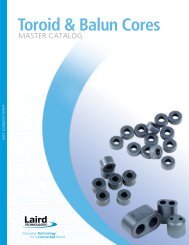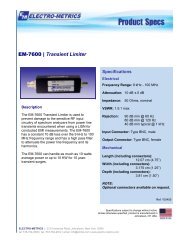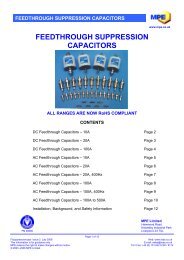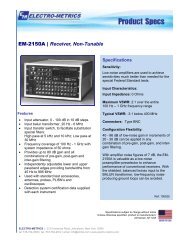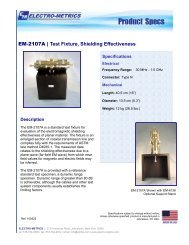28 Material - Ferrishield
28 Material - Ferrishield
28 Material - Ferrishield
Create successful ePaper yourself
Turn your PDF publications into a flip-book with our unique Google optimized e-Paper software.
How to select a FerriShield Ferrite for your application<br />
1<br />
2<br />
3<br />
Choose a ferrite material<br />
FerriShield ferrites are offered in (4) unique formulations. The chart below offers an overview<br />
of typical material properties and catalog page references.<br />
Ferrite Performance Catalog Pages<br />
<strong>28</strong> <strong>Material</strong>- Most Popular Wideband 10MHz-1GHz (250MHz peak) 10 to 21<br />
33 <strong>Material</strong>- Low-Frequency Ferrite 1MHz-60MHz (30MHz peak) 22 to 23<br />
25 <strong>Material</strong>- High-Frequency Ferrite 1MHz-1.2GHz (700MHz peak) 24 to 25<br />
20 <strong>Material</strong>- Bluetooth/Microwave 2.45GHz peak 26 to 27<br />
For detailed Attenuation and <strong>Material</strong> Properties see page 32 and 33<br />
Select a mounting option<br />
Each section of this catalog features multiple mounting options for bisected and solid<br />
bead ferrites. FerriShield Ferrites are recognized for their ease of installation and reliable<br />
performance over time.<br />
Select the inside diameter of your ferrite<br />
FerriShield Ferrites are designed to fit tight against the cable or wiring bundle that requires<br />
shielding. Ideally, you should select a ferrite with an inside diameter that is slightly less<br />
(+/- .04”) than the outside diameter of your cable.<br />
For quick reference, all part numbers in this catalog have an accompanying technical drawing<br />
and specifications chart that illustrates dimensions and impedance for the selected ferrite.<br />
For a more detailed technical explanation see page 33.<br />
Helpful Tips and Insider Hints<br />
• Ferrite performance typically increases as ferrite volume increases. The larger the<br />
ferrite mass, the better the RF attenuation.<br />
• Smaller cables can be looped through larger ferrites to increase performance.<br />
Impedance increase by the square of the number of loops. For example, by<br />
looping a cable through a ferrite 2 times (2 2 ), impedance increases by a factor of 4.<br />
For a detailed explanation see page 6- Electromagnetic Characteristics<br />
• Ferrite installation guidelines and recommendations are shown on page 35<br />
• Attenuation properties by part number can be referenced on page 32<br />
• Maximum recommend cable size by part number can be found on page 33<br />
5



